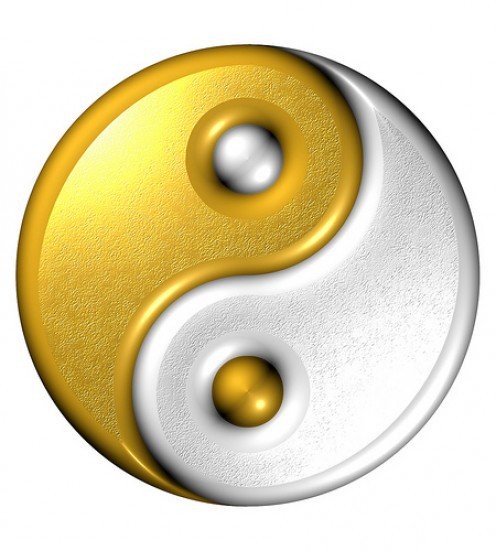Taoism also known as Daoism, is a religious or philosophical tradition of Chinese origin which emphasizes living in harmony with the Tao. The Tao is a fundamental idea in most Chinese philosophical schools; in Taoism, however, it denotes the principle that is both the source, pattern and substance of everything that exists. Taoism differs from Confucianism by not emphasizing rigid rituals and social order. Taoist ethics vary depending on the particular school, but in general tend to emphasize wu wei (effortless action), “naturalness”, simplicity, spontaneity, and the Three Treasures: “compassion”, “frugality” and “humility”.
The roots of Taoism go back at least to the 4th century BCE. Early Taoism drew its cosmological notions from the School of Yinyang and was deeply influenced by one of the oldest texts of Chinese culture, the Yijing, which expounds a philosophical system about how to keep human behavior in accordance with the alternating cycles of nature. The Tao Te Ching, a compact book containing teachings attributed to Laozi, is widely considered the keystone work of the Taoist tradition, together with the later writings of Zhuangzi.
By the Han dynasty (206 BCE–220 CE), the various sources of Taoism had coalesced into a coherent tradition of religious organizations and orders of ritualists in the state of Shu (modern Sichuan). In earlier ancient China, Taoists were thought of as hermits or recluses who did not participate in political life. Zhuangzi was the best known of these, and it is significant that he lived in the south, where he was part of local Chinese shamanic traditions. Women shamans played an important role in this tradition, which was particularly strong in the southern state of Chu. Early Taoist movements developed their own institution in contrast to shamanism, but absorbed basic shamanic elements. Shamans revealed basic texts of Taoism from early times down to at least the 20th century. Institutional orders of Taoism evolved in various strains that in more recent times are conventionally grouped into two main branches: Quanzhen Taoism and Zhengyi Taoism. After Laozi and Zhuangzi, the literature of Taoism grew steadily and was compiled in form of a canon—the Daozang—which was published at the behest of the emperor. Throughout Chinese history, Taoism was nominated several times as a state religion. After the 17th century, however, it fell from favor.

Taoism has had a profound influence on Chinese culture in the course of the centuries, and Taoists, a title traditionally attributed only to the clergy and not to their lay followers, usually take care to note distinction between their ritual tradition and the practices of Chinese folk religion and non-Taoist vernacular ritual orders, which are often mistakenly identified as pertaining to Taoism. Chinese alchemy especially neidan, Chinese astrology, Chan (Zen) Buddhism, several martial arts, traditional Chinese medicine, feng shui, and many styles of qigong have been intertwined with Taoism throughout history. Beyond China, Taoism also had influence on surrounding societies in Asia.
Today, the Taoist tradition is one of the five religious doctrines officially recognized in the People’s Republic of China (PRC) as well as Taiwan and although it does not travel readily from its East Asian roots, it claims adherents in a number of societies. It particularly has a presence in Hong Kong, Macau, and in Southeast Asia.
Relations with other religions and philosophies
Many scholars believe Taoism arose as a countermovement to Confucianism. The philosophical terms Tao and De are indeed shared by both Taoism and Confucianism, and Laozi is traditionally held to have been a teacher of Confucius. Zhuangzi explicitly criticized Confucianist and Mohist tenets in his work. In general, Taoism rejects the Confucianist emphasis on rituals, hierarchical social order, and conventional morality, and favors naturalness, spontaneity, and individualism instead.
The entry of Buddhism into China was marked by significant interaction and syncretism with Taoism. Originally seen as a kind of “foreign Taoism”, Buddhism’s scriptures were translated into Chinese using the Taoist vocabulary. Representatives of early Chinese Buddhism, like Sengzhao and Tao Sheng, knew and were deeply influenced by the Taoist keystone texts. Taoism especially shaped the development of Chan (Zen) Buddhism, introducing elements like the concept of naturalness, distrust of scripture and text, and emphasis on embracing “this life” and living in the “every-moment”.
Taoism on the other hand also incorporated Buddhist elements during the Tang period, such as monasteries, vegetarianism, prohibition of alcohol, the doctrine of emptiness, and collecting scripture in tripartite organisation.
Ideological and political rivals for centuries, Taoism, Confucianism, and Buddhism deeply influenced one another. For example, Wang Bi, one of the most influential philosophical commentators on Laozi (and Yijing), was a Confucian. The three rivals also share some similar values, with all three embracing a humanist philosophy emphasizing moral behavior and human perfection. In time, most Chinese people identified to some extent with all three traditions simultaneously. This became institutionalized when aspects of the three schools were synthesized in the Neo-Confucian school.
——
Religion World is one and only indian website to give information of all religions. We are dedicated to present the religions. You can send any info, news, engagements and advice to us on – religionworldin@gmail.com – or you can WhatsApp on – 9717000666 – we are also on Twitter, Facebook and Youtube.









